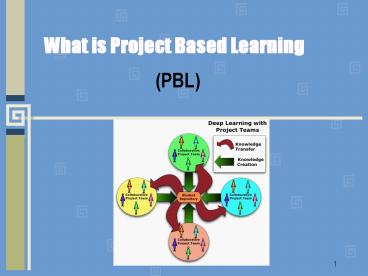What is Project Based Learning - PowerPoint PPT Presentation
1 / 13
Title:
What is Project Based Learning
Description:
is a constructivist pedagogy that intends to bring about deep learning by ... Responsible for their own learning/self directed learning/discovery learning ... – PowerPoint PPT presentation
Number of Views:402
Avg rating:3.0/5.0
Title: What is Project Based Learning
1
What is Project Based Learning
- (PBL)
2
Problem Based Learning ( PBL )
- Definition-
- is a constructivist pedagogy that intends to
bring about deep learning by allowing learners to
use an inquiry based approach to engage with
issues and questions that are rich, real and
relevant to their lives. - Project-based learning is a comprehensive
instructional approach to engage students in
sustained, cooperative investigation (Bransford
Stein, 1993).
3
PBL
- Encourages the use of higher order thinking
skills and learning concepts- Blooms Taxonomy - Responsible for their own learning/self directed
learning/discovery learning (Bruner,1966) - Done by groups of students working together
toward a common goal (Jigsaw method)
4
PBL
- Allows for a variety of learning styles (visual,
auditory kinesthetic) - Teacher is a facilitator of learning (ZPD)
- Utilizes various modes of communication
- Plays a role in assessment and evaluation- Rubric
- Student self-assessment of learning
5
The Role of Technology
- Word processors, spreadsheets, and databases-
drafting essays, analyzing numerical data. - E-mail, electronic mailing lists, forums, and
other online applications -communication and
collaboration. - Web provides access to museums, libraries, and
remote physical locations for research.
6
PBL
- Complex issues that require students to
investigate - E.g
- monitor the water quality in a local river to
learn about their local environment - environmental issues that affect it.
7
Advantages
- allow learners to apply multiple intelligences in
completing a project- which people think, learn
and process information- (Gardner, 1983) - Cooperative, active, collaboration Learning
- Motivation
- helps students develop a variety of social skills
relating to group work
8
Criteria for creating PBL
- Course Overview
- Student Learning Objectives
- Teaching Methods/Class Format
- Texts and Required Reading
- Units of Work
- Class Assignments
- Evaluation and Grading Procedures
- Bibliography
9
Sample website 1
- Save the Rainforests
- http//www.geocities.com/hookerm12000/savetherainf
orests - Plants
- http//www.dedham.k12.ma.us/webquest/summer2002/lp
/plantswebquest.htm (extra)
10
Sample website 2
- Our solar system
- http//questgarden.com/51/51/0/070516153949/
11
References
- 1.Bejamin,S(2000). Bloom Taxonomy of educational
objectives.(Online), Retrieved 3 September,
2007from World Wide Web - http//www.coun.uvic.ca/learn/program/hndouts/bloo
m.html - 2.Mette, H.R(2001).Vygotsky theories and
life.(Online), Retrieved 3 September,2007 from
World Wide Web - http//evolution.massey.ac.nz/assign2/MHR/indexvyg
.html
12
References
- 3.Smith, M. K. (2002) 'Howard Gardner and
multiple intelligences', the encyclopedia of
informal education. (Online), Retrieved 3
September, 2007 from World Wide Web - http//www.infed.org/thinkers/gardner.htm.
13
References
- http//www.bie.org/index.php/site/PBL/overview_pbl
/ - http//pblmm.k12.ca.us/PBLGuide/WhyPBL.html
- http//pbl-online.org/
- http//www.techlearning.com/db_area/archives/TL/20
03/01/project.php































